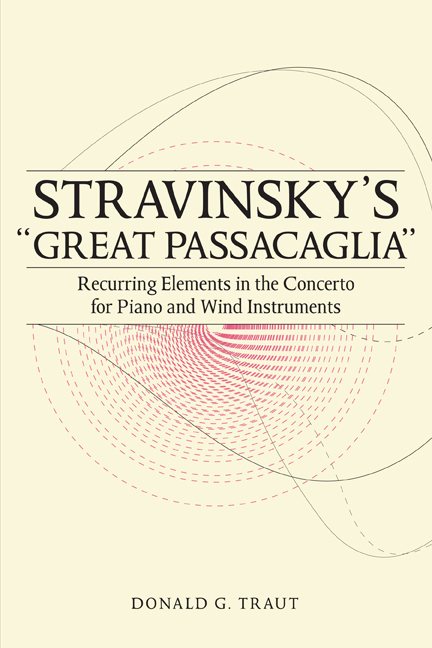Book contents
- Frontmatter
- Dedication
- Contents
- Acknowledgments
- Introduction
- 1 Context and Composition
- 2 Concerto as Catalyst
- 3 Analytical Tools and Recurring Elements
- 4 Counterpoint and Tonality in the First Movement
- 5 Tetrachords and Tritones in the Largo
- 6 Points of Imitation in the Finale
- Conclusion
- Appendix
- Notes
- Bibliography
- Index
Introduction
Published online by Cambridge University Press: 12 August 2020
- Frontmatter
- Dedication
- Contents
- Acknowledgments
- Introduction
- 1 Context and Composition
- 2 Concerto as Catalyst
- 3 Analytical Tools and Recurring Elements
- 4 Counterpoint and Tonality in the First Movement
- 5 Tetrachords and Tritones in the Largo
- 6 Points of Imitation in the Finale
- Conclusion
- Appendix
- Notes
- Bibliography
- Index
Summary
Since its completion in 1924, Stravinsky's Concerto for Piano and Wind Instruments has been many things to many people. For Stravinsky, it was both a major artistic accomplishment in his burgeoning neoclassic style and a vehicle for financial gain; it carried him throughout Europe as a touring soloist and was instrumental in bringing him to America for the first time. For the audiences who attended those concerts, it was very likely the first truly original neoclassic piece by Stravinsky they had heard. For many critics, it came to represent all that was wrong with Stravinsky's new style. For others, it pointed the way forward, even while it referred back to earlier models. For scholars, it initiated a call for new avenues into understanding tonality in the new century. In the repertoire for wind ensembles, it continues to hold a welcome place as an original composition by a composer of the highest stature.
This inventory draws attention to the significance of the Concerto, which represents—both artistically and biographically—so many important new elements in the life of the Russian master. His performing career went hand-in-hand with his increasing comfort as a conductor, a discipline that sustained him longer than playing. His 1925 visit to America affected him so strongly that he would eventually move there permanently. He changed as a composer as well. After the Concerto, he composed his pieces primarily one at a time, from conception to premiere, not in the dovetailing manner that had sustained him through his Russian period. Individually, these may all seem like small matters, but when taken as a whole, they become cause for notice.
Attributing such significance to the Concerto may seem misplaced to some. It is neither his most famous neoclassic piece nor his most critically acclaimed. Anyone who knows the Concerto is aware of its quirks: the slow, intricately contrapuntal introduction by a quartet of horns, the dry and sometimes shrill orchestration, the simplistic repeated-note theme, and the third-movement Fugato that comes out of nowhere. In many ways, however, the Concerto is like a lot of his other music from this era. Its surface textures remind us of Baroque genres. Its three movements lay out in the fast–slow–fast arrangement typical of seventeenth-century concerti. Its unique sense of tonality leaves us feeling somewhere between comfortable and uncertain.
Information
- Type
- Chapter
- Information
- Stravinsky s "Great Passacaglia"Recurring Elements in the Concerto for Piano and Wind Instruments, pp. 1 - 4Publisher: Boydell & BrewerPrint publication year: 2016
